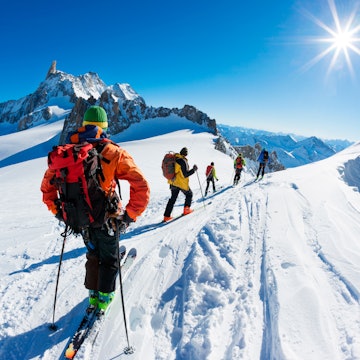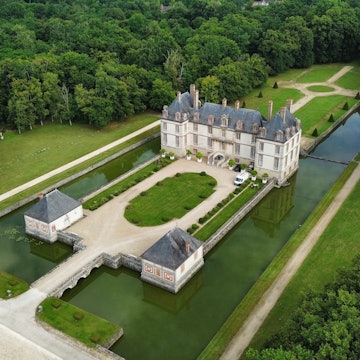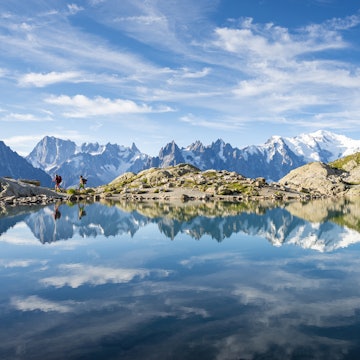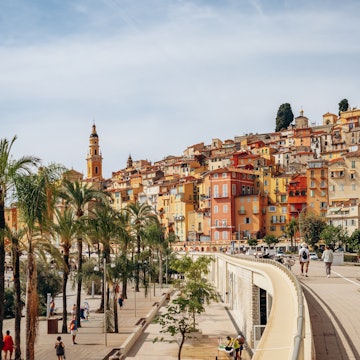

Ride the cable car for top-of-the-world views from Le Brévent. Puripat Lertpunyaroj/Shutterstock
The springboard to some of Europe's most fêted mountain adventures, Chamonix has always been one ski spin ahead of the curve. This pioneering ski town and mountaineering base in the French Alps was first discovered as a tourist destination by British explorers William Windham and Richard Pococke in 1741, and it hosted the first ever Winter Olympics in 1924.
Walking down Chamonix's pedestrian main street, rue du Docteur Paccard, below the looming mass of Mont Blanc's snow-white dome, it's impossible not to feel a sassy new spring in your step and a palpable buzz of anticipation at the next outdoor thrill around the corner. Here are the 15 best things to do in this famous bucket-list playground in the Alps.

1. Glide to the summit of Aiguille du Midi
Rising from the Mont Blanc massif, the great rocky fang of Aiguille du Midi (3842m/12604ft) is one of Chamonix’s most distinctive features, and taking in the 360-degree views of the French, Swiss and Italian Alps from the summit is (quite literally) breathtaking.
You can float over the 2800m (9186ft) dividing Chamonix from Aiguille du Midi on the Téléphérique de l’Aiguille du Midi cable car. There's a change of cabin at Plan d'Aiguille du Midi station at 2317m (7601ft). providing an opportunity to grab a nerve-steadying coffee or vin chaud (hot wine) at the station's mountain hut.
This is also a great spot to acquaint yourself with the many aiguilles (pinnacles) sculpting Chamonix's distinctive skyline. An information panel in front of the mid-point station identifies each of the rocky spurs soaring overhead.
Planning tip: Dress warmly for the trip to Aiguille du Midi – even in summer, temperatures can be positively frigid.
2. Learn about Chamonix history at Musée Alpin
Take a wander through Alpine history at this diverting two-level museum in the center of Chamonix, covering everything from butter moulds and farming tools of yore to the dawn of the 18th-century tourism boom. You’ll find out about the early days of Chamonix's high mountain guides and learn fascinating stories about the first female alpinists.
One of Europe's highest museum complexes, the Musée Alpin squirrels away a rabbit warren of themed espaces (spaces) covering every aspect of life in this famous mountain valley.
Planning tip: The museum is closed for renovations, but in 2025 you can still enjoy an educational experience outside the museum walls at one of its regular scheduled cultural events.
3. Witness markers of climate change at Mer de Glace
France’s largest glacier, the Mer de Glace ("Sea of Ice”), flows for 7km (4.3 miles) down the northern side of Mont Blanc, scarred with crevasses formed by the immense pressure of its steady movement down the mountainside.
The Train du Montenvers, a picturesque, 5km-long (3.1-mile) cog railway, opened in 1909, linking Gare du Montenvers with Montenvers, from where a cable car will deliver you to the Grotte de Glace cavern via a stairway.
On a more sombre note, look out for plaques on the walk down indicating the changing height of the glacier between 1985 and 2018. It's one thing to read about climate change and shrinking glaciers, but seeing it in person is particularly alarming!
4. Admire nature’s buried beauties at the Musée des Cristaux
Amateur geologists take note – within this small museum are beautifully lit collections of crystals, many gathered from the area around Mont Blanc. The adjoining Espace Tairraz exhibition space focuses on the art and science of mountaineering, with creative interactive displays and photos and videos of seemingly impossible ascents.
Until December 2027, the museum will be hosting a temporary exhibition featuring the collection of Raymond Thibault (1929–2014), a passionate mineralogist and gemmologist, featuring a hundred specimens collected from around the world during his travels.
5. Enjoy outdoor thrills on Le Brévent
The highest peak on the western side of the Chamonix Valley, Le Brévent (2525m/8284ft) offers tremendous views of the Mont Blanc massif. Myriad hiking trails lead through the surrounding nature reserve, and there are ledges to paraglide from and some vertiginous black ski runs.
Also here are the Brévent slabs, a popular rock climbing site located a 5-minute walk from the top cable car station, facing Mont Blanc. Family-friendly trails begin at the mid-point cable car stop at Planpraz (2000m/6563ft); from here, you can follow the trail to the Grand Balcon Sud or visit Lac Blanc.
Planning tip: To reach Le Brévent, board the Télécabine de Planpraz just west of the tourist office in Chamonix, then transfer to the Téléphérique du Brévent.

6. Hike to Lac Blanc
Set at 2352m (7717ft), this jewel-like glacial lake – its name literally means “White Lake” – is surrounded by the razor-sharp peaks of the Aiguilles Rouges, and it is usually accessible to hikers from the second half of June through to October. A walk of just a few kilometers west along the valley from Télésiège de l'Index will lead you to stunning Lac Blanc (after a 30m/98ft climb).
There's also a more challenging trail accessible from the Télécabine de la Flégère. Starting from the La Flégère ski area, this chairlift climbs to 2595m (8513ft); at the top, you can gasp at jagged mountain views before embarking on an even more scenic walk. A moderate 7km (4.3-mile) trail follows the Chamonix-Mont-Blanc Valley's western flank to turquoise Lac Blanc at 2352m (7716ft), offering views over breathtaking Alpine scenery.
Local tip: Swimming in the lake is prohibited to protect it for future generations, but it's worth coming purely to admire the views.
7. Go paragliding over Chamonix
The Chamonix-Mont-Blanc Valley is an iconic destination for paragliding. On clear days in summer and winter, the skies are speckled with colorful paragliders wheeling down from the heights. Tandem flights for first-timers with an experienced co-pilot depart from Planpraz and prices start at €140 (US$156) per person. Flights from the Plan de l’Aiguille (for experienced flyers only) cost at least €300 (US$334).
Planning tip: Ask around for recommended operators – there are several choices – and book your flight a couple of days in advance.

8. Marvel at the ephemeral Grotte de Glace (Ice Cave) in winter
Carved out every year since the mid-19th century, the manmade Grotte de Glace is like an ephemeral art installation. Visitors are able to step inside the glacier, to marvel at the colors, and lights shimmering off the ice. To reach the cavern, you'll need to get to Montenvers station, before jumping onto a cable car and then descending around 200 steps to enter the bowels of the Mer de Glace glacier.
9. Get off-piste on La Vallée Blanche
This jaw-dropping ski route with a 2800m (9186ft) descent is the ride of a lifetime and probably Europe's most famous off-piste experience. Beginning at the Aiguille du Midi, the 20km (12.4-mile) route darts over several crevasse-riddled glaciers and skiers return to Chamonix via the Montenvers train.
Skiers must be comfortable on ungroomed terrain, confident on black pistes and in good physical shape; the reward is access to a landscape of eerie, unearthly beauty. The route can only be tackled with a guide de haute montagne (certified mountain guide). Your guide will provide you with an avalanche beacon and mountaineering harness (for use in the event of a crevasse rescue).
Planning tip: Go to the Chamonix tourist office website and download their app for public-transport schedules, weather forecasts, webcams, piste maps, hiking and biking trails, and to purchase and top-up lift passes.

10. Spot mountain wildlife in the Parc de Merlet
For a change of pace, move from the cosmopolitan high life of high-octane Chamonix into a valley of baroque chapels, villages and hamlets where time scarcely moves at Parc de Merlet. Set above Les Houches at 1500m (4921ft), this splendid alpine wildlife reserve is a walkers' paradise, with the incredible scenery of the Mont Blanc massif punctuated by traditional mountain chalets.
The experience is elevated by the opportunity to spot marmot, deer, chamois or ibex in the wild. Take your time and walk quietly. In winter, the park is blanketed with snow and visitors must join guided snowshoe walks.
Planning tip: The Office de Haute Montagne provides vital practical information on hiking trails and weather forecasts in the area.

11. Let your tastebuds run free in Chamonix
From post-piste burgers to Michelin-starred gastronomy, Chamonix has something for everyone. Restaurants and European-style pubs cluster most densely around rue des Moulins, but all neighbourhoods are pretty well served with eating options in season.
Most restaurants open seven days a week during the winter ski season and in high summer (July and August), but have reduced hours (or close completely) out of season. If money is no object, book dinner at MUMMA where craft cocktails and Franco-Asian shared plates are overseen by skilled chef David Lillieroth.
Another top dining option is Rose du Pont, where Belle Époque Paris meets Chamonix, and romantic balconies overlook the river. For the best coffee in town, head to Moody Espresso Bar, where the beans are roasted on site – pair a coffee with a sublime cinnamon roll.
Planning tip: If it’s picnic supplies you’re after, head to Coopérative Fruitière du Val d'Arly for Savoyard cheeses and saucissons (air-dried sausages); they come studded with Beaufort cheese, hazelnuts, blueberries, and all sorts of other unusual ingredients.

12. Embrace the best of Chamonix nightlife
Whether you're looking for a glammed-up cocktail bar, a spit-and-sawdust pub, or something in between, Chamonix nightlife rocks. At Moö, by Chamonix's train station on busy ave Michel Croz, the strapline is “Walk in, dance out." This Swedish-run bar is a classic first port-of-call after leaving the slopes, and it rocks from 4pm. Across the street at Chambre Neuf, après-skiers slam plastic glasses of Stella and dance on tables until the live music ends at around 8:30pm.
More bars pepper rue des Moulins, some with terraces overlooking the milky-green River Arve. Anglophone dive bar Bard'd Up attracts an international set with its Irish, English and Aussie paraphernalia, pool table, sports screenings, live bands, and club vibe.
From Wednesday to Saturday, alternative concerts pack out sophisticated garden-bar Maison des Artistes to bursting – don't miss the boutique gin collection. Amnesia Club, Chamonix's biggest nightclub and party temple, stays open until 1:30am; check its Facebook page for themed parties and entrance fees.

13. Go wet and wild in Chamonix
Summer thrill seekers can challenge themselves with a day of canyoning, rafting or “hydrospeeding” on the River Arve. Hydrospeeding is like boogie boarding along river rapids wearing a full wetsuit and flippers, while a canyoning session will involve waterfall abseiling and tobogganing down natural waterslides.
Local operators will meet you in town for a briefing and equipment training session, before taking you or your group to one of several locations at the foot of Mont Blanc. First-timers get a gentle introduction to these adrenaline-pumping white-water activities, but once you’ve mastered the basics, you can come back for a more intensive trip.

14. Hire a mountain bike (or e-mountain bike) and hit the trails
Lower-altitude trails such as the Petit Balcon Sud are perfect for mountain biking around Chamonix. More experienced mountain bikers can tackle harder ascents, plus thrilling downhill trails through woods and open meadows, using ski lifts for uphill stretches to save time and energy.
Most outdoor-activity specialists in town can arrange guided mountain-biking expeditions, or you can rent a bike and go on your own adventure. Local operators rent out everything from basic hardtail mountain bikes to full suspension electric mountain bikes and fat bikes for winter snow biking.
15. Take the kids for a ride on the Luge sur Rails
Thrill-seekers can fly down 1.3km (0.8 miles) of hairpin turns on Chamonix's alpine coaster, the Luge sur Rails in Chamonix. This exhilarating toboggan ride is open year-round at the city's Parc de Loisirs. Riders strap in and zip down a track that offers stunning views as it twists and turns and executes a 540-degree spin. It’s family-friendly, and children over three are permitted to ride accompanied by an adult.
This article was adapted from Lonely Planet’s France guidebook, published in May 2024.















